Understanding the basic principles behind orbital tube welding may help you arrive more rapidly at the optimum weld procedure for your specific application.
By Bernard Mannion and Jack Heinzman III
Orbital welding was first used in the 1960s, when the aerospace industry recognized the need for a superior joining technique for aerospace hydraulic lines. A mechanism was developed in which the arc from a Tungsten electrode was rotated around the tubing weld joint. The arc welding current was regulated with a control system thus automating the entire process. The result was a more precision and reliable method than the manual welding method it replaced.
In the early 1980s, Orbital welding became practical for many industries when combination power supply/control systems were developed that operated from 110 VAC. These systems were physically small enough to be carried from place-to-place on a construction site for multiple in-place welds. Modern day orbital welding systems offer computer control, where welding parameters for a variety of applications can be stored in memory and later called up for a specific application. Hence, the skills of a certified welder are thus built into the welding system, producing enormous numbers of identical welds and leaving significantly less room for defects.
Orbital Welding Equipment
In the orbital welding process, tubes/pipes are clamped in place, and an orbital weldhead rotates an electrode and electric arc around the weld joint to make the required weld. An orbital welding system consists of a power supply and an orbital weldhead.
The power supply/control system supplies and controls the welding parameters according to the specific weld program created or recalled from memory This supply provides the control parameters, the arc welding current, the power to drive the motor in the weldhead, and switches the shield gas(es) on/off as necessary.
Orbital weld heads are normally of the enclosed type, and provide an inert atmosphere chamber that surrounds the weld joint. Standard enclosed orbital weld heads are practical in welding tube sizes from 1/16 inch (1.6 mm) to 6 inches (152 mm) with wall thicknesses of up to .154 inches (3.9 mm). Larger diameters and wall thicknesses can be accommodated with open style weld heads.
Reasons for Using Orbital Welding Equipment
Sidebar - Can it save you money?
There are many reasons for using orbital welding equipment. The ability to make high quality, consistent welds repeatedly, at a speed close to the maximum weld speed, offer many benefits to the user:
- Productivity. An orbital welding system will drastically outperform manual welders, many times paying for the cost of the orbital equipment in a single job.
- Quality. The quality of a weld created by an orbital welding system (with the correct weld program) will be superior to that of manual welding. In applications such as semiconductor or pharmaceutical tube welding, orbital welding is the only means to reach the weld quality requirements.
- Consistency. Once a weld program has been established, an orbital welding system can repeatedly perform the same weld hundreds of times, eliminating the normal variability, inconsistencies, errors, and defects of manual welding.
- Skill level. Certified welders are increasingly hard to find. With orbital welding equipment, you don't need a certified welding operator. All it takes is a skilled mechanic with some weld training.
- Versatility. Orbital welding may be used in applications where a tube or pipe to be welded cannot be rotated or where rotation of the part is not practical. In addition, orbital welding may be used in applications where access space restrictions limit the physical size of the welding device. Weld heads may be used in rows of boiler tubing, where it would be difficult for a manual welder to use a welding torch or view the weld joint.
Many other reasons exist for the use of orbital equipment over manual welding. For example, applications where inspection of the internal weld is not practical for each weld created. By making a sample weld coupon that passes certification, the logic holds that if the sample weld is acceptable, that successive welds created by an automatic machine with the same input parameters should also be sound.
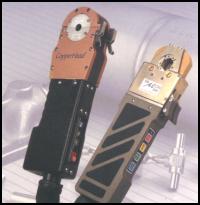 |
| Standard enclosed orbital weld heads are practical in welding tube sizes from 1/16 inch (1.6 mm) to 6 inches (152 mm) with wall thicknesses of up to .154 inches (3.9 mm) Larger diameters and wall thicknesses can be accommodated with open style weld heads. |
General Guidelines for Orbital Tube Welding
For orbital welding in many precision or high purity applications, the base material to be welded; the tube diameter(s); weld joint and part fit-up requirements; shield gas type and purity; arc length; and Tungsten electrode material, tip geometry, and surface condition may already be written into a specification covering the application.
Each orbital welding equipment supplier differs slightly in recommended welding practices and procedures. Where possible, follow the recommendations of your orbital equipment supplier for equipment set-up and use, especially in areas that pertain to warranty issues. Note that, this section is only intended as a guideline for those applications where no specification exists. The engineer responsible for the welding must create the welding set-up, and derive the welding parameters, in order to arrive at the optimum welding solution.
Welding Basics and Set-Up
The Physics of the GTAW Process
The orbital welding process uses the Gas Tungsten Arc Welding process (GTAW), as the source of the electric arc that melts the base material and forms the weld. In the GTAW process (also referred to as the Tungsten Inert Gas process -- TIG) an electric arc is established between a Tungsten electrode and the part to be welded. To start the arc, an RF or high voltage signal (usually 3.5 to 7 KV) is used to break down (ionize) the insulating properties of the shield gas and make it electrically conductive in order to pass through a tiny amount of current. A capacitor dumps current into this electrical path, which reduces the arc voltage to a level where the power supply can then supply current for the arc. The power supply responds to the demand and provides weld current to keep the arc established. The metal to be welded is melted by the intense heat of the arc and fuses together.
Material Weldability
The material selected varies according to the application and environment the tubing must survive. The mechanical, thermal, stability, and corrosion resistance requirements of the application will dictate the material chosen. For complex applications, a significant amount of testing will be necessary to ensure the long term suitability of the chosen material from a functionality and cost viewpoint.
In general, the most commonly used 300 series stainless steels have a high degree of weldability with the exception of 303/303SE which contain additives for ease of machining. For hundred series stainless steels are often weldable, but may require post weld heat treatment.
Accommodation must be made for the potential differences of different material heats. The chemical composition of each heat batch number will have minor differences in the concentration of alloying and trace elements. These trace elements can vary the conductivity and melting characteristics slightly for each heat. when a change in heat number is make, a test coupon should be make for the new heat. Minor changes in amperage may be required to return the weld to its original profile.
It is important that certain elements of the material be held to close tolerances. Minor deviations in elements, such as sulfur, can vary the fluid flow in the weld pool, completely changing the weld profile and causing arc wander.
 |
| For orbital welding, the goal is to have the minimum sufficient weld penetration to consistently weld through the tube wall. |
 |
| How electrode tip geometry affects the weld profile. |
Weld Joint Fit-Up
Weld joint fit-up is dependent on the weld specification requirements on tube straightness, weld concavity, reinforcement, and drop through. If no specification exists, the laws of physics will require that the molten material flow and compensate for tube mismatch and any gap in the weld joint.
Tubing is produced according to tolerances that are rigid or loose according to the application for which the tube was purchased. It is important that the wall thickness is repeatable at the weld joint from pat to part. Differences in tube diameter or out-of-roundness will cause weld joint mismatch and arc gap variations from one welding set up to another.
Tube and pipe end prep facing equipment is recommended in order to help ensure end squareness and end flatness. Both the O.D. and O.D. should be burr free with no chamfer.
When two tubes are butted together for welding, two of the main considerations are mismatch and gaps. In general, the following rules apply:
- Any gap should be less than five percent of the wall thickness. It is possible to weld with gaps of up to 1- percent ( or greater) of wall thickness, but the resultant quality of weld will suffer greatly, and repeatability will also become a significant challenge.
- Wall thickness variations at the weld zone should be +/- five percent of nominal wall thickness. Again, the laws of physics will allow welding with mismatch of up to 25 percent of wall thickness if this is the only challenge. Again, the resultant quality of weld will suffer greatly, and repeatability will become an issue.
- Alignment mismatch (high-low) should be avoided by using engineering stands and clamps to align the two tubes to be welded. This system also removes the mechanical requirements of aligning the tubes from the orbital weldhead.
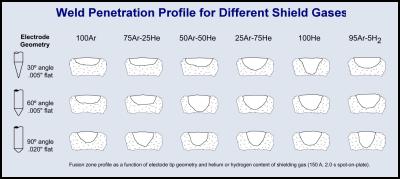 |
| Minor changes in sulfur content can change weld pool flow characteristics with a dramatic effect on penetration (The Maragoni Effect). |
Shield Gas(es)
An inert gas is required on the tube O.D. and I.D. during welding to prevent the molten material from combining with the oxygen in the ambient atmosphere. The objective of the welder should be to create a weld that has zero tint at the weld zone I.D.
Argon is the most commonly used shield gas (for the O.D. of the tube and the purge gas (for the I.D. of the tube). Helium is often used for welding on copper material. Mixed gases, such as 98 percent Argon/two percent Hydrogen; 95 percent Argon/five percent Hydrogen; 90 percent Argon/10 percent Hydrogen; or 75 percent Helium/25 percent Argon may be used when the wall thickness to be welded is heavy (.1" or above). Using mixtures of 95 percent Argon/five percent Hydrogen is incompatible with carbon steels and some exotic alloys, often causing hydrogen embrittlement in the resultant weld. As a general rule, for simplicity and reduction of shield gas cost, use 100 percent Argon gas.
Gas purity is dictated by the application. For high purity situations, where the concern for micro-contamination is paramount, such as semiconduction and pharmaceutical applications, the shield and purge gases must minimize the heat tint that could otherwise be undesirable. In these applications, ultra high purity gas or gas with a local purifier are employed. For non-critical applications, commercial grade argon gas may be used.
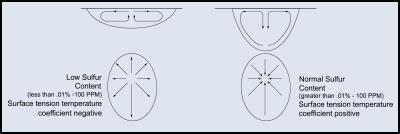 |
| The combination of the electrode tip geometry and shield gas can have a major effect on the weld penetration, weld quality, welding speed, and electrode life. |
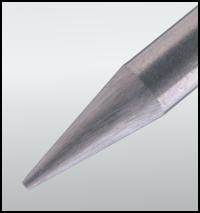 |
| Using pre-ground electrodes ensures that the electrode material quality, tip geometry, and ground electrode surface input to the welding process is constant. |
Tungsten Electrode
The Tungsten welding electrode, the source of the welding arc, is one of the most important elements of the welding system that is commonly ignored by welding system users. Users continue to manually grind and wonder why they produce inconsistent results. Whether in manual or automatic welding, this is the area where manufacturing organizations can improve the consistency of their welding output with minor effort.
Basically, the objective for the choice of Tungsten parameters is to balance the benefits of a clean arc start and reduced arc wander with good weld penetration and satisfactory electrode life.
Electrode Materials
For quite some time, Tungsten manufacturers have added an oxide to pure Tungsten to improve the arc starting characteristics and longevity of pure Tungsten electrodes. In the orbital welding industry, the most commonly used electrode materials are two percent thoriated Tungsten and two percent ceriated Tungsten.
| Many users of the TIG welding process do not realize that the welding electrode they use contains Thorium, a radioactive element added to the Tungsten. |
Safety
The safety issues of Tungsten electrode material are now being looked at more closely. Many users of the TIG welding process do not realize that the welding electrode the use contains Thorium, a radioactive element added to the Tungsten. While the radioactivity is of a low level, it brings an issue of danger, especially with the radioactive dust that is generated when grinding the electrodes to a point for welding.
Alternative, non-radioactive Tungsten materials are now available, such as two percent ceriated electrodes, which often offer superior arc welding. While these materials are commercially available they have been largely ignored until recently.
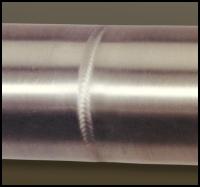 |
| A typical orbital tube weld. Note the pulsed arc finish on the weld surface. |
Recommended Electrode Materials
Cerium, as a base material, has a lower work function than Thorium, offering superior emission characteristics. So, not only do ceriated electrodes offer an advance in electrode safety, they also improve the arc starting ability of the orbital equipment. However, as mentioned earlier, it is always best to follow the advice of your orbital equipment manufacturer.
Electrode Tip Geometry
Given the ever-increasing weld quality requirements of the final weld, more and more companies are looking for ways to ensure that their weld quality is up to par. Consistency and repeatability are key to welding applications. The shape and quality of the Tungsten electrode tip is also being recognized as a vital process variable. Once a weld procedure has been established, it is important that consistent electrode material, tip geometry, and surface condition be used.
Welders should follow an equipment supplier's suggested procedures and dimensions first, because they have usually performed a significant amount of qualifying and troubleshooting work to optimize electrode preparation for their equipment. However, where these specifications do not exist, or the welder or engineer would like to change those settings to possibly improve and optimize their welding, the following guidelines apply:
Electrode Taper
This is usually called out in degrees of included angle usually anywhere between 14deg and 60deg). Below is a summary chart that illustrates how different tapers offer different arc shapes and features:
| Sharper Electrodes | Blunter Electrodes |
| Last less than blunt | Last longer |
| Less weld penetration | Better weld penetration |
| Wider arc shape | Narrower arc shape |
| Handle less amperage | Handle more amperage |
| Less arc wander | Potential for more arc wander |
| More consistent arc | Less consistent arc |
To demonstrate graphically how the taper selection will effect the size of the weld bead and the amount of penetration, the drawing on page 20 show typical representations of the arc shape and resultant weld profile for different tapers.
Electrode Tip Diameter
Grinding an electrode to a point is sometimes desirable for certain applications, especially where arc starting is difficult or short duration welds on small parts are performed. In most cases, however, it is best for a welder to leave a flat spot or tip diameter at the end of the electrode. This reduces erosion at the thin part of a point, and reduces the concern that the tip may fall into the weld. Larger and smaller tip diameters offer the following trade-offs:
| Smaller Tip | Larger Tip |
| Easier to start | Usually harder to start |
| Less arc wander | More chance of arc wander |
| Less electrode life | More electrode life |
| Less weld penetration | More weld penetration |
Tungsten Electrode Grinder and Pre-Ground Electrode
Using electrodes pre-ground to requirements or a dedicated commercial electrode grinder to provide electrode tip quality and consistency, offers the following benefits to the user in their welding process:
- Improved arc starting, increased arc stability, and more consistent weld penetration.
- Longer electrode life before electrode wear or contamination.
- Reduction of Tungsten shedding. This minimizes the possibility of Tungsten inclusions in the weld.
- A dedicated electrode grinder helps ensure that the welding electrodes will not become contaminated by residue or material left on a standard shop grinder wheel.
- Tungsten electrode grinding equipment requires less skill to ensure that the Tungsten electrode is ground correctly and with more consistency.
Pre-Ground Electrodes
Rather than risk electrode radioactivity issues, and constantly endure the variability of each operator grinding the electrodes with a slightly different touch, many manufacturing organizations have chosen to purchase electrodes pre-ground. Since a small difference in the dimensions of an orbital electrode can produce a big difference in the weld results, pre-ground electrodes are the preferred electrode choice to maintain the consistency of your welding. This low-cost option ensures that the electrode material quality, tip geometry, and ground electrode surface input to the welding process is constant. Consult electrode charts or a pre-ground electrode supplier to obtain the electrode diameter and tip geometry that is most suitable for your welding application.
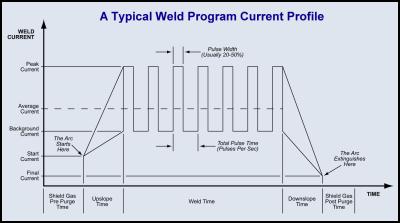 |
| This weld profile shows a single level of weld time. Orbital welding normally uses a minimum of four levels of weld time, with each level decreasing in weld amperage as the tube heats up during the welding process. |
Conclusion
In conclusion, the important points to remember are:
- Orbital welding has been used by many industries to improve the quality and quantity of tube welding when compared to what can be accomplished by manual welders.
- The effective cost of an employee computes to be significantly more that just his base salary. The output of a $20 per hour skilled welder actually costs over $72,000 per year (almost twice his yearly base wage).
- If a complete orbital welding system costs between $15,000 and $20,000 and can output over twice the amount of welding that a manual welder can produce when the equipment will pay for itself in a matter of months.
- Finally, the volume of welds that are produced by an automated welding system will far exceed that of a manual welder. In addition to weld quality improvements, this will bring two additional financial benefits: One, increased output per day at lower cost. Two, lowered scrap and rework costs due to improved weld consistency.
No comments:
Post a Comment